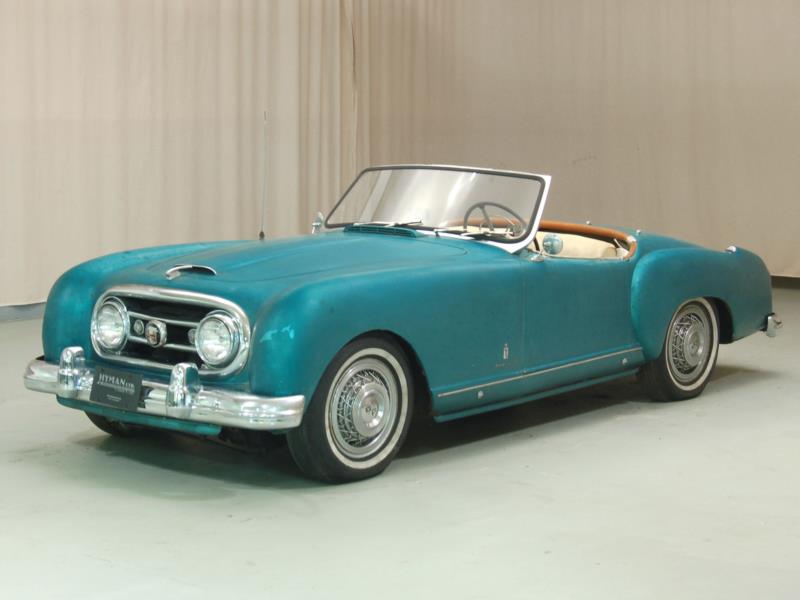-
Insurance
InsuranceAbout our productsLearn about insuringGet a quote Get current values, historical values, model history and more.
-
Valuation
ValuationHagerty valuation toolLook up a vehicle value Get current values, historical values, model history and more.
-
Events
EventsHagerty official eventsHagerty ClubhouseEvent calendar
-
Entertainment
EntertainmentMore to explore
- Portal login
1954 Nash-Healey Series 25
Base Convertible 4.1 L
Vehicle values by condition
Fair
Condition 4
£35,100
#4 cars are daily drivers, with flaws visible to the naked eye. The chrome might have pitting or scratches, the windshield might be chipped.
Good
Condition 3
£52,700
#3 cars could possess some, but not all of the issues of a #4 car, but they will be balanced by other factors such as a fresh paint job or a new, correct interior.
Excellent
Condition 2
£64,100
#2 cars could win a local or regional show. They can be former #1 cars that have been driven or have aged. Seasoned observers will have to look closely for flaws.
Concours
Condition 1
£95,600
#1 vehicles are the best in the world. The visual image is of the best car, unmodified, in the right colours, driving onto the lawn at the finest concours.
Insurance premium for a
1954 Nash-Healey Series 25 Base Convertible 4138
valued at £52,700
£262.33
/ year*
History of the 1951 - 1954 Nash-Healey Series 25

1951 - 1954 Nash-Healey Series 25
Model History: Nash-Healey Roadster,Le Mans Coupe and G-Type (1951 to 1954)
In 1950, Donald Healey and George Mason, the chairman of Nash-Kelvinator, devised a way to supply Healey with the engines he was hoping would power his next project, and simultaneously give Nash a product that could invigorate its dying nameplate by opening up the American market. A prototype was built shortly after an agreement was reached, and the resulting Nash-Healey hit the track. With Tony Rolt and Duncan Hamilton driving, the car finished fourth at Le Mans, which convinced Mason that Nash had its halo car and proved to Healey that he had sufficient power.
Early cars were fitted with the Ambassador's 125-hp, 3848cc I6 engine, modified with high-compression aluminium heads, hotter cams and dual SU side-draft carburettors. The cars received a suspension system similar to the ones utilised with much success on the Silverstone Healey, with coil springs and roll bars front and back, a front trailing link setup, and a solid rear axle. Aluminium bodies were originally made by Panelcraft in Birmingham, but in 1952, Pininfarina revised the design. Around the same time, the car received a new engine: a 125-hp, 4138cc was fitted from S/N N-2251.
Despite a large price tag, standard equipment was basic: a 3-speed Borg Warner manual transmission with overdrive, leather seats, chrome disc wheels, whitewall tires, plexiglass side windows, hydraulic drum brakes, and a tilt steering wheel. The two-door convertible did not sell well, although it continued to have some racing success (thanks in great part to endurance rather than all-out speed), finishing ninth at the 1951 Mille Miglia and sixth at the 1951 Le Mans. To capitalise on this association, a fixed-head coupe was introduced in 1953 and bore the 'Le Mans'.
Although the Nash-Healey was never officially sold in the UK, a 'Three Litre Sports Convertible' (more commonly known as the Alvis-Healey G-Type) was offered by Healey. This used a modified version of the early Nash-Healey body mounted on a new chassis, was powered by a 2,993cc Alvis engine mated to a four-speed gearbox and offered a high interior specification and 100mph top speed.
Just 506 examples of the Nash-Healey and 25 Alvis-Healey G-Types were produced from 1951 to 1954. Today, all the models are rare and offer a route into many prestigious motoring events. The Nash-Healey roadster is slightly more collectable than the coupe, and the G-Type an extremely rare beast, with a handful believed to have survived.
Hagerty Newsletter
Get your weekly dose of car news from Hagerty UK in your inbox

ADVERTISEMENT